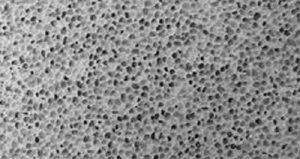Foam concrete
It consists mainly of air pores and cement with fillers such as fly ash or sand.do not use Coarse aggregates in foamed concrete and the air pores in foam concrete are formed by agitating air with a foaming agent. The range of air bubble size from 0.3 to 0.4 mm. The volume of air consists of at least 20% of concrete volume. The foam concrete possesses high flowability, controlled low strength, and excellent thermal insulation, low self-weight. The density of foam concrete limits from 400 kg/m3 to 1600 kg/m3 with a compressive strength limit from 1 to 15 Mpa. The high flowability of foam concrete eliminates the need for using mechanical vibration to consolidate concrete during placement.
it can be produced either by the mixed foaming method or the pre-foaming method. In the pre-foaming method, the base mix (filler, cement, water) and the stable preformed aqueous foam are produced separately. Then blending the foam and the base mix together. In the mixed foaming method, the active surface agent is mixed with the ingredients(filler and cement)of the base mix, and during the mixing, the foams will be formed.
Properties of foam concrete:
Self-compacting:
It can fill the smallest voids without the need for mechanical vibration. They will not exert high stress on formwork due to the low self-weight of foam concrete. high flowability of foam concrete allows easier placement of concrete.

Drying shrinkage:
it has a high drying shrinkage. Foam concrete is estimated to be 10 times greater than the normal concrete. The drying shrinkage of foam concrete is reduced with density, and this is attributed to lower paste content affecting the shrinkage in low-density mixes.
The high drying shrinkage is attributed to the absence of aggregates in foamed concrete.
Fire resistance:
The fire resistance tests have shown that the foam concrete under fires doesn’t spall like normal density concrete. it possesses a high resistance to fire.
Thermal insulation:
it has high thermal insulation. The cellular microstructure of foam concrete The high thermal insulation is attributed.
Resistance to the aggressive environment:
They are with low density and provide excellent resistance to thaw-freezing cycles of water. Also offers good foam concrete resistance to aggressive chemical attacks such as sulfate.
Application of foam concrete:
Building blocks:
It can be used to produce building blocks for patriation and foam concrete used for the load-bearing walls with any dimension.

Floor screed:
It can be used to create a flat surface on uneven ground, and foam concrete can be used to raise the floor levels.
Roof insulation:
It possesses excellent thermal and sound insulation properties. It can be used for roof insulation. Concrete of the low self-weight will not impose a large loading in the building.
Road sub-base:
It is being used as a road sub-base on a bridge. They are lightweight so that the loading imposed on the bridge is minimized.
Material Components and Preparation
The basic parts of foam concrete consist of water, filler, binder, foaming agent, additive, and fiber. The state of the art findings and research on these components to date are described as follows.

Water:
The water necessary for constituent material depends on composition, the stability of the mortar body, consistency.
Binder:
Cement is the most commonly used for the binder. The binder is ordinary Portland cement.
Foaming agent:
The foaming agent determines foam concrete density by controlling the generation rate of the bubbles in cement paste.
Filler:
difference fillers such as fly ash, limestone powder, silica fume.
Additive:
It is commonly used include the water-proofing additive, retarder, water reducer, coagulation accelerator, etc.
Fiber:
A variety of fibers are added into foam concrete so as to improve reduce shrinkage and strength.
We Love Cricket